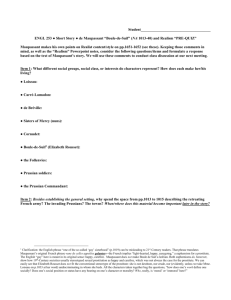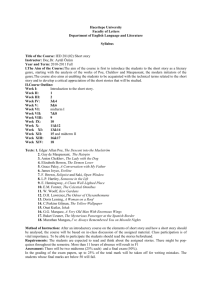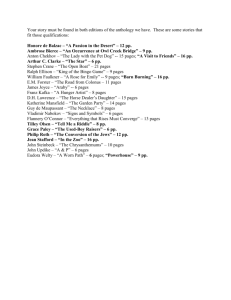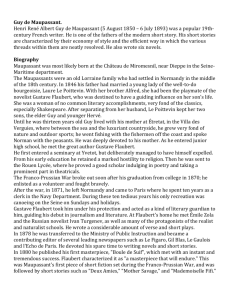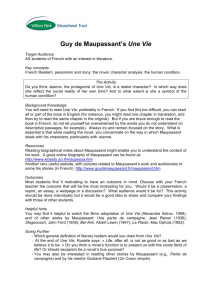Introduction to Literature
advertisement
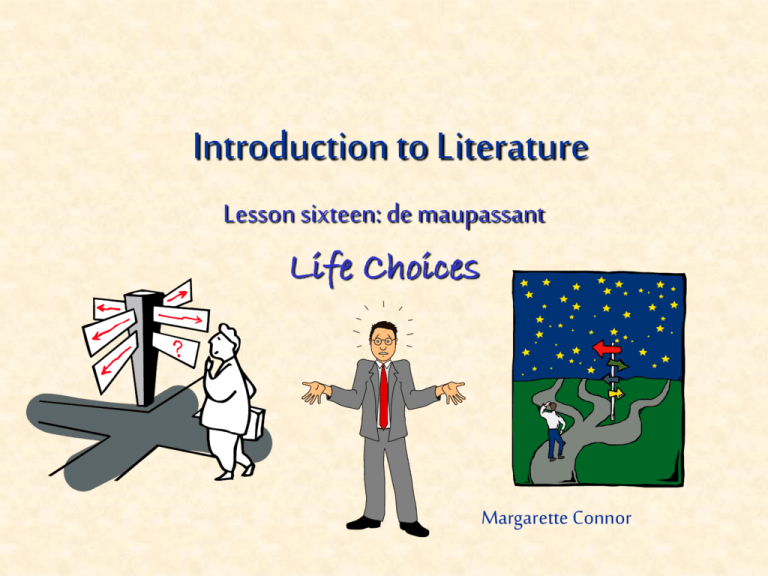
Introduction to Literature Lesson sixteen: de maupassant Life Choices Margarette Connor Contents • Introduction • de Maupaussant biography • Realism • Naturalism • “The Necklace” discussion Introduction • Slight departure slightly from what we’ve been looking at in the previous 15 lectures. • Reading in translation, which slightly changes how we look at the story. Reading in translation • Not very different from reading a story in its original language, but there are some subtle differences. • The most important is language. – You are reading a third party’s words, and different translators may make subtle differences to the text. Language and tone • When we discuss language and tone, we must be aware that we are speaking of a translator’s choice. • For today I’ve read two different translations of the story – while most of the story was identical (something easy to do with a Maupassant story as his writing is very straightforward), there were some words that were different. Guy de Maupassant (1850–1893) • A master short story writer. • His influence is felt all over the world. Most famous short stories • “The Necklace” (“La Parure”) • “The Ball of Fat” (“Boule de suif,” the nickname of a prostitute), • “The Heritage” (“L’Héritage”), • “The House of Mme Tellier” (“La Maison Tellier”) • “Moonlight” (“Clair de lune”) • “The Piece of String ” (“La Ficelle”) Greatest novels • A Life (Une Vie, 1883), about the disillusioning life of a lonely woman; • Bel-Ami (1885), describing the career of a selfish journalist; • Pierre et Jean (1888), a study of the hatred of two brothers; • Our Hearts (Notre Cœur, 1890), showing the emotional life of an unhappily married man. Beginnings • Born August 5, 1850, in Normandy, France. • His father, Gustave, was a member of the ancient French nobility. a stock broker, gambler, and amateur painter. • His mother, Laure Le Poittevin, was strong and domineering Unhappy childhood • Maupassant’s parents’ marriage was bitter and unhappy. • They separated when he was 11 years old. • He was raised by his mother. – The relationship was none too happy due to his mother’s dominating spirit, and many of the strong, overbearing women in his stories are modelled on her. Well educated • First at the Lycee Napoleon in Paris. • Then Lycee de Rouen, from which he earned his bachelor’s degree in 1869. Military service • At the age of 20, Maupassant served in the military during the FrancoPrussian War. • He saw no combat. Civil service • After he left the military, he entered government service. • From 1872 until 1880 he served as a clerk in various government ministries. Flaubert’s influence • Flaubert decided to train his godchild in the art of writing fiction. • Helped to develop Maupassant’s keen eye for observation and his attention to detail. • As we go through the story we’ll see that Maupassant rarely tells us things. – He shows us, and it is through the showing that the reader is led to draw his or her own conclusions. Flaubert’s realism • One of the things Flaubert also introduced to Maupassant was the idea of realism in his writings. Realism • “In theory, the realist, wishing to record life as it is, refrains from imposing a pre-determined pattern (based perhaps on a philosophical orientation) upon his materials. He allows the story ‘to tell itself,’ for truth, he feels, resides in the events themselves rather than in his imagination. (con’t) Realism, continued • “Free of Romantic subjectivity, realistic writing emphasizes truthfulness of detail. The ‘theory’ of realism, however, is not to be taken without reservations, for any artist must shape the materials of his art into a form which derives from his personal vision.” (Beckson and Ganz, Literary Terms, a dictionary). Topics covered • Writers who use realism are usually concerned with the commonplaces of everyday life and the middle and lower social classes. • We see much of this in Maupassant’s writing. Not all realism is the same • “From the beginning of the ‘realistic movement,’ which dates from the midnineteenth century, there has been no universally accepted set of principals governing the manner or content of socalled realistic works. In French literature, the realism in the fiction of Flaubert, Balzac and Maupassant is as different as it is in such American authors as Sherwood Anderson and John Steinbeck.” (Beckson and Ganz, Literary Terms, a dictionary). Literary friends • Through Flaubert, Maupassant got to know many of the world’s best writers: • • • • Emile Zola, Algernon Swinburne, Ivan Turgenev, Henry James. Considered brilliant by peers • He often attended Flaubert’s famous salons, or gatherings of the literary elite. Among them, the best and the brightest, Maupassant was considered brilliant. Zola’s influence • Through Zola Maupassant was introduced to naturalism, a literary movement that is related to realism, but is sometimes called an extreme form of realism. A bust of Zola. Naturalism defined • “This doctrine holds that all existent phenomena are in nature and thus within the sphere of scientific knowledge; it maintains that no supernatural realities exist.” (con’t) Naturalism, continued • “Taine applied [these ideas] to literature, maintaining that psychological states as well as human actions were the results of material causes.” (Beckson and Ganz, Literary Terms, a dictionary). Theorist of naturalism • Zola is considered the great theorist of naturalism. In his essay “The Experimental Novel,” he argued that the novelist should be free from any moral conventions or preconceived theories. • Is this is truly possible? • The filter of our own ruling ideologies is almost impossible to shed. Maupassant carries on tradition • He often shows actions and allows the readers to draw conclusions. • He never comments on Mathilde’s actions, but allows us to form our own conclusions about her character from her actions. • But of course, he controls our reactions on some level by choosing which actions to show us. How he makes his point • He doesn’t comment on his characters, but he shows us his meaning and purpose through choosing to tell us about greedy, covetous and vain characters Poet first • Although his first publication was a book of poetry, his poetry is not his strength as a writer. Maupassant and a friend at a picnic. Ten years of literary genius • By 1880 he started to publish his short stories. • Between 1880 and 1890, Maupassant wrote practically all of his great literature, including six novels and over 300 short stories. Destroyed by syphilis • Maupassant’s health was destroyed by the time he was 37. • Mainly as the result of syphilis, which he had contracted in his youth. • But he also helped it along with too much drink, rich food and wild living. Madness takes its toll • Syphilis can drive people mad as it affects the brain. • By the time he was 40, he started losing his mental abilities. • As he got older and the disease became more advanced, his stories took on a more and more horrific nature. – In two of his stories he describe madness and its accompanying fear with terrifying accuracy. The end • In January 1892, driven mad by the advanced syphilis, Maupassant tried to commit suicide by cutting his throat. • He was committed to a private asylum in Paris, where he died early the next year. Unhappy victims • Because of his adherence to realism and naturalism, many of his characters as unhappy victims of their greed, desire, or vanity but he presents their lives without sermonizing or outwardly moralizing. “The Necklace” • In this story, we see many of Maupassant’s characteristics: – Vanity and pride destroying people – No commentary on the action, but the action speaks for itself. Layer upon layer of irony • The controlling irony of the story, which we learn in the final line. • The irony of Mathilde’s pride. That was her problem, not fate or chance, but she never sees this. • The irony that when she had a middle class life, she hated it, but when forced into poverty, she lives without complaint. “Pride goeth before a fall” • We see pride destroying the life of the Loisels. • Both Loisels resorted to deception. • Their pride didn’t allow them to tell on themselves, but they might have saved themselves years of pain and suffering. • Yet another irony. Detached narrator • Some critics have said that this narrator is so detached that the description seems almost cruel. • What do you think? View of women • Critics often point to the misogyny in Maupassant’s stories. • It’s true that Mathilde is not a great example of womanhood. • What do you think? Prostitutes • Lest we condemn poor Maupassant out of hand, I should note that many of his prostitutes are very positive characters. • This might be saying something itself. – Could the subtext be that at least the whores are honest about selling themselves? A thought. But what does this tell us? • "Now listen carefully: Marriage, to me, is not a chain but an association. I must be free, entirely unfettered, in all my actions -my coming and my going; I can tolerate neither control, jealousy, nor criticism as to my conduct. (con’t) “I pledge my word, however, never to compromise the name of the man I marry, nor to render him ridiculous in the eyes of the world. But that man must promise to look upon me as an equal, an ally, and not as an inferior, or as an obedient, submissive wife. My ideas, I know, are not like those of other people, but I shall never change them." (from Bel Ami, 1885) Go to the story now~!! • She has simple taste. • She suffered from the poorness of her family. • 4th paragraph • She’s hurting herself. • She’s wants to be object of desire • A brilliant place to stop. An irony ending. • The point of the story what would happen to people because of vanity, pride, and poverty-- To cover things?
